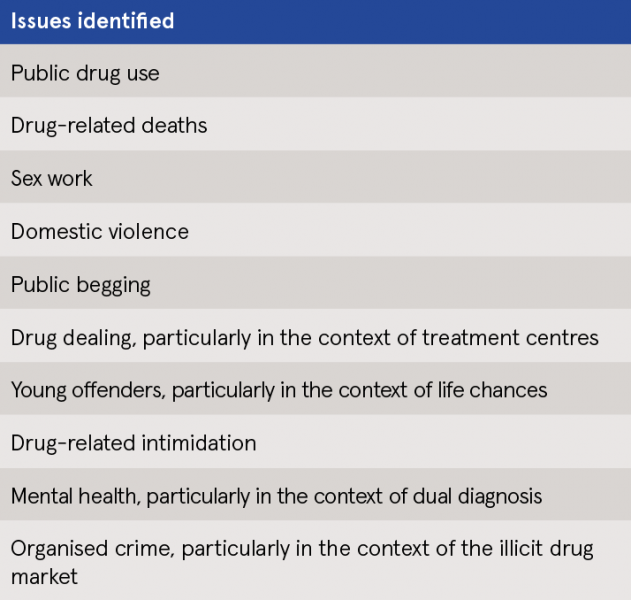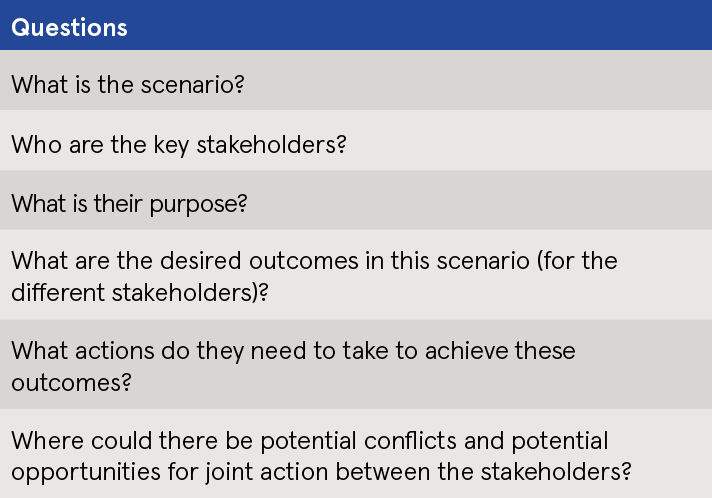Guiney, Ciara (2020) Policing with trust. Drugnet Ireland, Issue 75, Autumn 2020, pp. 7-8.
| Preview | Title | Contact |
|---|---|---|
|
PDF (Drugnet 75)
590kB |
In July 2020, the Ana Liffey Drug Project published a report on the proceedings of the Policing in Changing Policy Environments event, held at Dublin Castle in June 2019.1 Forty national and international experts came together with the aim of sharing knowledge and understanding as well as exploring challenges and experiences in the areas of law enforcement and public health. The Chatham House Rule was applied to the event and to the final report. The event consisted of two sessions: the morning focused on providing information (presentations and discussions), while the afternoon involved interaction (plenary sessions and facilitated working groups).
Session 1
The topics addressed during session 1 covered a range of themes.
Theme 1: Role of the police
Delegates believed that the role of the police has evolved. Traditionally, policing has focused on detecting and prosecuting crime. However, more and more they respond to a wide range of social issues. For example, cases that centre on harm account for 80% of their workload. A possible explanation put forward is that An Garda Síochána is the only ‘first responder’ service available that can respond to a broad range of issues 24/7 (p. 7).
Theme 2: Public health and policing
Delegates acknowledged that public health and law enforcement overlapped. Many who experience problems with mental health, behaviour, or substance use may not receive or have access to suitable services. In consequence, these individuals may come into contact with the law or may be excluded, or may experience higher levels of adversity. It was noted that interventions can have negative and positive consequences. For example, there can be increased trauma for individuals instead of determining how challenges brought them into contact with the law in the first place. Principles that were viewed as important to community safety and first-response settings included using person-centred approaches, aimed at decreasing crime, stigmatisation, and traumatisation. These should be applied in the community, courts, and prison systems.
Theme 3: Need for meaningful partnerships
Meaningful partnerships that centred on ‘joint commitments, a shared vision and a shared understanding of goals’ (p. 8) were considered the most appropriate way to target community safety issues. The role carried out by police was acknowledged along with the challenges that arise in balancing interventions that provide support, while at the same time ensuring that individuals are accountable for their actions from the perspective of detecting and prosecuting crime. It was also acknowledged that establishing ‘a working multi-agency system takes time, commitment, flexibility, compromise, and good communication’ (p. 9).
Theme 4: Structural issues
The final theme that emerged centred on international and domestic structural issues that may act as a barrier to developing person-centred policy. One delegate noted that ‘drug policies in most countries of the world are not contributing to public health’ (p. 11). While the individual was deemed to be at the centre of any response, addressing drug use punitively via law enforcement has not been successful and often resulted in more harm to those that are disadvantaged. Despite this, drug policies globally have centred on a coercive approach. Moreover, the illicit drug market was identified as an area that created additional harms. Delegates noted that in order to focus on public health, the underlying assumptions that drug policies are centred on – namely, that ‘criminalisation is necessary, that (outside legitimate uses) a drug free world is possible or desirable’ (p. 11) – need to be critically examined and questioned. Other issues identified at a domestic level included structural challenges in service delivery; structural barriers that could restrict genuine partnership; and personality-led innovations. Attempts to overcome these issues depended on appropriate mandates being in place along with a commitment and shared understanding of how partnerships work.
Table 1: Relevant cross-cutting scenarios or issues for Ireland

Table 2: Questions addressed by working groups

Session 2
Session 2 consisted of plenary sessions and interactive workshops. The aim of this session was to provide delegates with an opportunity to investigate the difficulties of addressing issues of community safety by considering the challenges that communities are faced with. The session started with an overview of the Irish context and included participants reflecting on practical experience observations and government policy. Several areas were highlighted, including Ireland’s commitment to using a health-led and person-centred approach to drug use; ongoing development of policing services; and international attention for recent progressive policy developments. Table 1 illustrates the main issues identified.
With the aim of increasing understanding, motivations, roles, and potential intervention opportunities, four of the issues/scenarios identified in Table 1 were examined in more detail in breakout working groups (n=4). The main questions utilised to explore these issues are shown in Table 2.
Group 1: Organised crime
In the area of organised crime, more specifically the illicit drug market, delegates identified the key stakeholders involved. For example, the individual buying and taking drugs; local drug supplier; family of drug user; police; government; and community bodies. It was noted that while commonalities exist between stakeholders, for example community safety, there may also be competing objectives in terms of what should be prioritised.
Group 2: Mental health
The emphasis here was on dual diagnosis, where individuals presented with substance use disorder along with another mental health problem. The key stakeholders identified included the individual experiencing the dual diagnosis; their family or carers; health and social stakeholders involved in their care; and first responders to a crisis, which is often law enforcement officers. Delegates recognised that different roles occurred within these groups along with alternative beliefs regarding treatment. However, they believed that ultimately interventions should be centred on the needs and human rights of the individual. Challenges identified included inflexible current structures and ensuring consistent case management.
Group 3: Drug-related intimidation
Using a street-level intimidation scenario, delegates identified several stakeholders. For example, individuals with drug debt and their families; the dealer; other third parties, such as a middle person; and the police. It was mainly believed that stakeholders had diverging or overlapping motives. Delegates noted the complexity of drug-related intimidation and that roles are not always clear-cut. The main outcome desired was that all players – the person owing the debt, the dealer, and anyone else involved – leave the drug market. However, because of the illicit nature of the drug market, there is no legal remedy or way to resolve disputes that arise, which has resulted in intimidation being the only route to debt recovery. While this was not expected to change, delegates believed that interventions existed that could be helpful.
Group 4: Young offenders and life chances
The final group examined young offenders, specifically challenges in relation to repeat offending. The key stakeholders identified included the young person; their family or carer; their school; and broader community. Consistent with issues identified by delegates in other groups, it was noted that roles and motives differed within stakeholder groups. Issues were deemed complex; however, opportunities were also noted. For example, the importance of credible role models was discussed along with service orientation, where it was acknowledged that a ‘one size fits all’ (p. 16) approach was not likely to work. It was also noted that youth engagement was often centred on negative behaviour, ‘what the person wasn’t doing, or wasn’t doing right’ (p. 17). Focusing on relationships and building strong networks away from their education/social support system was deemed more effective.
While these four issues/scenarios were not the same, they did have themes in common: issues in community safety, public health, and law enforcement consistently emerged.
Conclusion
Concluding reflections reiterated and reinforced the themes that emerged throughout the day. In particular, it was noted that openness to partnership was necessary. It was acknowledged that an already recognised common goal for many agencies was working together. However, alongside State bodies and non-governmental organisations it is vital that the community participate in community safety. Interventions put forward need to be tailored to the needs of the individual using a human rights approach characterised by trust and commitment by stakeholders. For the system to work, it must be believed that improvements will occur in community safety and policing. For this to occur change is inevitable. The full implementation of recommendations by the Commission on the Future of Policing in Ireland are a vital step in initiating change along with stakeholder willingness to build meaningful partnerships.2
1 Ana Liffey Drug Project (2020) Policing with trust. Dublin: Ana Liffey Drug Project. https://www.drugsandalcohol.ie/32223/
2 Commission on the Future of Policing in Ireland (2018) The future of policing in Ireland. Dublin: Commission on the Future of Policing in Ireland. Available online at: http://www.policereform.ie/en/POLREF/Pages/PB18000006
MM-MO Crime and law > Criminality > Youth (juvenile) offending
MM-MO Crime and law > Crime deterrence
MM-MO Crime and law > Justice and enforcement system
MM-MO Crime and law > Justice system > Community anti-crime or assistance programme > Community policing / police
MM-MO Crime and law > Justice system > Justice / enforcement agency > Police (Garda)
T Demographic characteristics > Person who commits a criminal offence (offender)
VA Geographic area > Europe > Ireland
Repository Staff Only: item control page